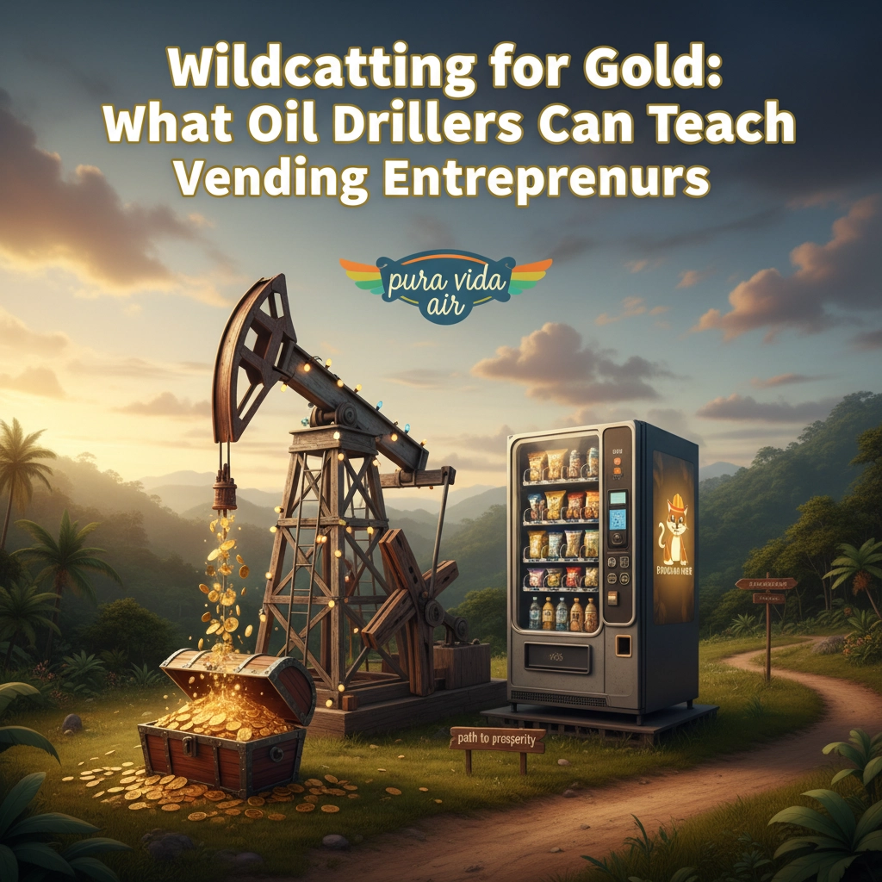Wildcatting for Gold: What Oil Drillers Can Teach Vending Entrepreneurs
Picture this: You're cruising around town with a shiny vending machine strapped to the back of your pickup truck, walking into random businesses like some kind of snack dispensing door to door salesperson.
You've got your pitch ready, your smile practiced, and your fingers crossed that the next manager you meet doesn't look at you like you just asked to set up a circus in their lobby.
Sound familiar? Congratulations, you're officially wildcatting!
Now, before you start picturing yourself in a hard hat drilling for crude oil (though honestly, some days the vending game feels just as messy), let's talk about what wildcatters actually do. These are the risk-taking legends of the oil world who sink millions into drilling wells in completely unproven territory. They're basically gambling with geology, hoping to strike black gold where nobody's ever found it before.
And you know what? That's exactly what we do in vending – just with fewer explosions and more energy drinks.
The difference between the wildcatters who strike it rich and those who go bust isn't luck. It's strategy, persistence, and the ability to learn from every dry hole they drill. So grab your metaphorical hard hat, because we're about to dive deep into the five phases that separate the vending pros from the wannabes.
🧭 Phase 1: Exploration , Finding the Right Ground
Real wildcatters don't just point at a random spot on the map and start drilling. They study geological surveys, analyze terrain, and research every successful (and failed) well in the area. They're detectives with drilling rigs.
As vending entrepreneurs, we need that same methodical approach:
Scout like your profits depend on it (because they do):
Foot traffic patterns: Are people actually walking by, or is this location deader than a gas station hot dog?
Dwell time: Do people hang around long enough to get hungry, or are they speed-walking past like they're late for a date?
Access points: Can people actually reach your machine without performing Olympic gymnastics?
Analyze the competition – and we're not just talking about other vending machines:
Is there already a vending presence saturating the area?
What about nearby restaurants, convenience stores, or cafeterias?
Sometimes the lack of competition is your biggest red flag – maybe there's a reason nobody else set up shop here.
Build relationships before you pitch:
Property managers are your new best friends (even if they don't know it yet)
Facility managers hold the keys to your kingdom
Even the maintenance crew can give you the real scoop on foot traffic
The goal here is simple: lower your dry-hole risk. Every piece of data you collect – from parking lot head counts to shift schedules – is your seismic reading. You're not just hoping for the best; you're engineering success.
⛏️ Phase 2: Drilling , Testing the Location
When oil teams drill a test well, they're all in. Equipment, crew, time, money – everything's on the line. That's your moment when your machine hits the floor and the real test begins.
You've invested in:
Equipment (your "rig" – aka that beautiful vending machine)
Stocked inventory (your "drilling fluid" – we prefer calling it "liquid happiness and crunchy goodness")
Time and energy (your "crew" – which is probably just you, a dolly, and maybe your reluctant cousin)
Now comes the nail-biting part: watching your first 30/60 days like a hawk. This isn't just about asking "Am I making money?" – you need to go full detective mode:
What's selling? (Spoiler alert: it's probably not the kale chips)
When are people buying? (3 PM slump, anyone?)
Who's your audience? (Office warriors? Gym rats? Night shift heroes?)
Here's the thing that separates the pros from the amateurs: every location teaches you something about human behavior. Some wells gush from day one. Others barely trickle. But either way, you just learned something that'll make your next placement exponentially smarter.
Don't let pride keep you in a losing spot. If a location isn't performing after giving it a fair shot, cut your losses and move that machine somewhere it can actually thrive. Your vending machine deserves better than being a fancy decoration.
⚙️ Phase 3: Production , Refining the Process
Once you hit a strong location, the game completely shifts. You're no longer crossing your fingers and hoping for the best – now you're optimizing like a mad scientist.
This is your refinery phase, and it's where the real money gets made:
Fine tune your prices:
Test small increases to find that sweet spot
Bundle deals can boost your average transaction
Sometimes a slight price drop on slow movers creates surprising volume
Optimize your product mix based on actual data:
That expensive protein bar nobody buys? Goodbye.
The cheap candy that flies off the shelves? Stock up, my friend.
Seasonal adjustments keep things fresh (literally and figuratively)
Keep your machine cleaner than your grandmother's kitchen:
A dirty machine screams "sketchy snacks inside"
Regular maintenance prevents those awkward "ate my dollar" conversations
Think of it as a storefront, because that's exactly what it is
The smartest operators don't just celebrate their hits, they scale the system that found them. You're not just running a vending machine; you're running a location-finding, customer-understanding, profit-optimizing machine.
🛢️ Phase 4: Expansion , Drilling the Field
Here's where wildcatting wisdom really shines: once you find a productive oil well, you don't immediately pack up and drill on the other side of the state. You drill more wells nearby because similar geology often means similar results.
In vending, this translates to expanding within the same ecosystem.
Hit gold with a gym machine? Time to scout:
Nearby offices (post workout protein needs are real)
Warehouses in the area (manual labor = serious snack demands)
Apartment complexes (convenience seeking residents)
Medical facilities (stressed healthcare workers are your friends)
Why does this work? Because successful locations share invisible characteristics:
Similar demographics
Comparable income levels
Shared lifestyle patterns
Complementary business hours
Don't chase shiny new markets until you've maximized the "oil field" around your proven producer. There's more gold in your backyard than you think.
💸 Phase 5: Risk, Reward, and Reinvestment
The best wildcatters don't blow their first big strike on fancy cars and expensive vacations. They reinvest those early profits into bigger, better drilling programs. Smart vending operators follow the exact same playbook.
Every profitable location funds the next one – it's the compound interest of vending entrepreneurship.
Here's your wildcatter's survival guide:
Data beats hope every single time:
Go where your metrics point you, not where you think you should go
Track everything: sales patterns, popular items, peak hours, seasonal changes
Let the numbers tell the story, even when it's not the story you wanted to hear
Diversify your wells:
Don't put all your machines in one building (or even one industry)
Spread your risk across different location types
One bad site doesn't end your business if you've planned properly
Automate and monitor:
Smart coolers with real time dashboards are your refinery control room
Remote monitoring saves gas money and sanity
Automated alerts prevent those "oops, everything's sold out" moments
Cut dry holes fast:
Never let pride keep you in a losing spot
Sometimes the best decision is admitting a location isn't working
Failed locations free up resources for better opportunities
🔥 The Hustler's Code
Wildcatting – whether for oil or optimal vending spots – isn't about luck, good vibes, or positive thinking. It's about pattern recognition, persistence, and learning from every strike and miss.
Every new site is a gamble, but every lesson compounds. The location that flopped last month taught you something valuable about foot traffic. The machine that's crushing it this week is showing you what your customers actually want (not what you think they want).
The real secret? Most people give up right before their breakthrough. They drill a couple of dry holes, get discouraged, and convince themselves the whole game is rigged. Meanwhile, the wildcatters who understand the process keep prospecting, keep drilling, and keep refining their approach.
So keep your eyes open, your data handy, and your machines moving. Somewhere out there, your next vending gusher is waiting – and now you've got the roadmap to find it.
Now get out there and start wildcatting. Your future self (and your bank account) will thank you.
Ready to strike vending gold? Check out our latest insights on location strategy, customer behavior, and turning those dry holes into profit pumping powerhouses. Because every wildcatter needs a good crew – and we've got your back.

























